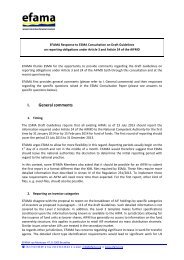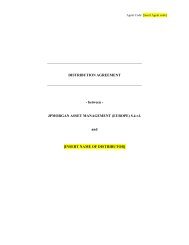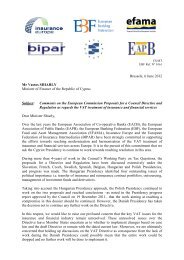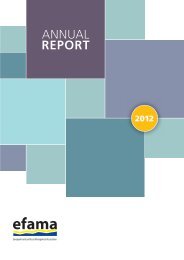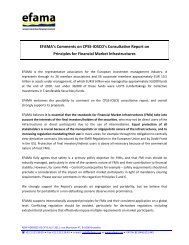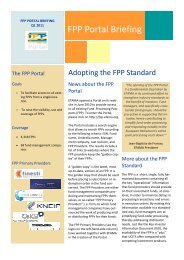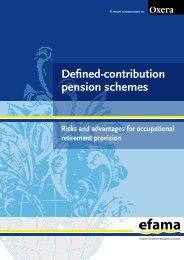EFAMA KPMG Solvency II Report
EFAMA KPMG Solvency II Report
EFAMA KPMG Solvency II Report
You also want an ePaper? Increase the reach of your titles
YUMPU automatically turns print PDFs into web optimized ePapers that Google loves.
4.2.2 Data Exchange Formats<br />
4 WORKING GROUP FINDINGS | 29<br />
Requirements<br />
The Pillar 3 QRTs that insurers must submit to the regulator are still to be fi nalised<br />
and current expectation is that final QRTs will be available in the autumn of 2012.<br />
To date there has been no guidance on the format for data that need to be exchanged<br />
across the industry in order that the templates can be completed by insurers. This is<br />
particularly an issue with regard to template QRT AS D4, due to the requirement to<br />
look-through.<br />
While standardisation could well take place over time, it would be better to establish<br />
this now and avoid the costs of creating costly processes which are subsequently<br />
reengineered.<br />
Challenges and Impacts<br />
It would be operationally challenging for an asset manager to provide the QRT data in<br />
numerous formats and templates. It would also be challenging for an insurer or asset<br />
manager to receive QRT data in multiple formats and either scenario would be likely to<br />
result in impacts on data quality, as it is harder to complete quality checks on numerous<br />
bespoke requirements than a standard set of requirements.<br />
Varied and numerous requests in different formats will also have knock on impacts on the<br />
consistency of definition across the industry, as there will be no consistent data exchange<br />
reference documentation.<br />
Potential Solutions<br />
An industry standard format for data exchange across the insurer and invested asset<br />
industry would provide greater clarity for asset managers, TPAs, and insurers, as they<br />
would know what format to produce data in, and expect to receive it in.<br />
For aggregate data, a standard data exchange template at the aggregated CIC, country<br />
and currency level would enable QRT AS D4 to be completed without the insurer<br />
needing to collect data at the granular holdings level. The aggregation would be done<br />
by the asset manager or TPA, and the data items would meet minimum <strong>Solvency</strong> <strong>II</strong><br />
requirements for QRT AS D4. This method would also resolve the issue relating to the<br />
disclosure of granular holdings data.<br />
Where firms require the individual holdings level data for Pillar 3 QRTs, a standard data<br />
exchange template at the granular, pre-aggregated level would enable consistency of<br />
definition and reporting of asset data across the industry.<br />
Firms will also be collecting data for Pillar 1. Standardisation of data at this level would<br />
focus on core data items required for Pillar 1, and minimise requests for all data or ‘nice<br />
to have’ items.<br />
The standard format would need to include standardised labelling to reflect the QRTs<br />
and create consistency of definition, so a data directory should therefore accompany<br />
the standard data exchange templates.<br />
© 2012 <strong>KPMG</strong> LLP, a UK limited liability partnership, is a subsidiary of <strong>KPMG</strong> Europe LLP and a member fi rm of the <strong>KPMG</strong> network of independent member fi rms affi liated with <strong>KPMG</strong> International<br />
Cooperative, a Swiss entity. All rights reserved.





